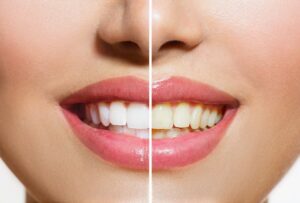
A bright, white smile is often associated with health, confidence, and beauty, so it’s no surprise that teeth whitening has become one of the most popular cosmetic dental treatments. While professional whitening treatments at the dentist’s office can deliver dramatic results, many people turn to over-the-counter (OTC) whitening products as a more affordable and convenient alternative. But do these products really work?
How OTC Teeth Whitening Products Work
Most over-the-counter teeth whitening products use a form of peroxide – either hydrogen peroxide or carbamide peroxide – as the active ingredient. These chemicals break down stains on the surface and slightly below the enamel to lighten the color of teeth.
OTC whitening options include:
- Whitening strips.
- Whitening toothpastes.
- Whitening trays and gels.
- Whitening pens.
- LED whitening kits.
Each of these products works in a slightly different way, and their effectiveness often depends on the concentration of peroxide and how long the product remains in contact with the teeth.
What OTC Products Can (and Can’t) Do
Over-the-counter whitening products can lighten teeth that have been stained by external sources like coffee, tea, red wine, and tobacco. Surface stains, also known as extrinsic stains, respond well to these products if used consistently over time.
However, OTC products are generally not strong enough to address deeper, intrinsic stains caused by medication, trauma, excessive fluoride, or natural aging. They also cannot whiten crowns, veneers, or fillings.
Additionally, whitening toothpastes may only remove surface stains through mild abrasives rather than through chemical bleaching. While these toothpastes can help maintain a whiter smile, they usually won’t produce dramatic whitening results on their own.
Limitations and Side Effects
One of the biggest drawbacks of OTC whitening products is that they typically contain lower concentrations of peroxide compared to professional treatments. This means they often require more time and repeated use to see noticeable results. Some people may see their teeth whiten by one or two shades, while others might not notice much of a change at all.
Another concern is improper application. Whitening strips may not cover all areas evenly, leading to patchy results. Ill-fitting trays can cause gel to leak onto the gums, leading to irritation or sensitivity.
Tooth sensitivity is the most common side effect of whitening, especially if products are overused. Gum irritation, though usually mild, can also occur.
Tips for Safe and Effective Whitening
- Follow the directions: Using products longer than recommended can increase sensitivity and damage enamel.
- Use ADA-approved products: Look for the American Dental Association Seal of Acceptance to ensure safety and effectiveness.
- Practice good oral hygiene: Brushing and flossing daily can help extend the life of your whitening results.
- Consult your dentist: Before starting any whitening regimen, especially if you have dental work or sensitive teeth, talk to your dentist.
Over-the-counter teeth whitening products can work, especially for mild to moderate surface stains, but they often require time and consistency to achieve visible results. While not as powerful or fast-acting as professional treatments, they are a budget-friendly option for many people looking to brighten their smile. Just remember: results may vary, and a dentist’s guidance is always your best bet for a safe and effective whitening experience.
About the Practice
Want to brighten your smile and look like you belong on the red carpet? At Complete Dental Care of Renton, we have both in-office and take-home whitening kits to give you choice and convenience with your treatment. Our warm, welcoming dental office will have you feeling like you’re at home, and with our highly experienced dentists, you’re bound to get the best care possible. Schedule your appointment online today or call (425) 226-5940.
